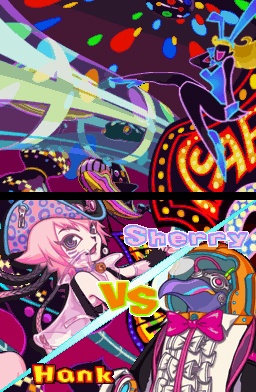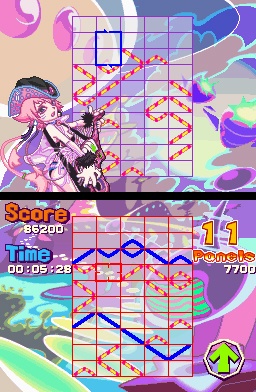Puzzle game players have contended with cubes, spheres, and other geometric shapes over the years, but lines have been pretty scarce, which is part of what makes Gunpey such a refreshing change of pace. It was originally released on the Japanese WonderSwan handheld, so the gameplay concept is relatively unknown in the West. Thank goodness for the modern makeover, because the core gameplay is strong, and the presentation is delightful.

Gunpey's premise is simple: Lines pointing in various directions pop onto the gameplay grid from the bottom, and you must connect them from left to right. Once you've linked one side to the other, the chain is locked, and you have a few seconds to add more lines before it is removed. While you can use the D pad and buttons to play, it's far simpler to use the touch screen: Just touch the line you wish to move and drag it to the desired position within the column. If a line is in the top row when the next row is due to appear at the bottom, the game is over. It sounds easy, but the underlying complexity soon becomes apparent.
The first challenge you'll need to overcome is to only move lines vertically, so it doesn't take long for a single column to collect multiple stray lines that you can't do anything with yet. Because new lines constantly push what's already there toward the top of the grid, you're wrestling not only with connecting them but also with moving the ones near the top further toward the bottom. Making a complete connection doesn't just cause the chain to explode, though; it also buys you time. Once the connection is created, the lines within it will freeze. You can either eliminate the chain right away or leave it frozen until it explodes automatically. Not only can you add other lines to the chain, but you can also move them through it, and no additional lines will pop up while your chain is actively frozen. This downtime presents an opportunity for you to get your stray lines in order.
At first, a grid full of lines looks a little minimalist because you're likely used to the more visually appealing shapes common to this style of game. But it's a nice change that grows on you once the levels start moving along. If you've already arranged your lines and are still waiting for the next row to appear, all you have to do is tap the B button or the arrow on the touch screen to pull them up. The first minute of play moves along slowly, but the closer the lines get to the top, the more quickly new rows appear. The resulting tapping is hectic and satisfying.
Frontier mode is Gunpey's main attraction. Here, you choose a character and fight through a variety of foes in a musical showdown. It's a strange premise because Gunpey is not really a rhythm or music game. The top screen shows a computer-controlled grid, while your own playing grid is on the touch screen, and after your enemy fills his playfield, you move on to the next. In standard difficulty, you can play through a set of opponents in about 30 minutes, and you can choose from three levels of difficulty. As you cycle through characters, you play on a variety of cowboy-themed skins called stages, as well as unlock new characters and stages as you progress. They're all vibrant, attractive, and accompanied by a mix of club tunes that don't seem to fit with the visuals. Yet it works, with a Lumines-brand fusion of music and sound effects that oddly suits the Japanese Old West style. However, there are times when the stages get too colorful. The lines on the gameplay grid aren't very crisp, and they can get easily lost, making it difficult to see what's going on in some of the skins.
Unlike the PSP version of the game, where much of the challenge lies in using the buttons to manipulate the pieces, the DS iteration is much simpler because of the touch screen. Sliding lines up and down doesn't take much effort, although you can avoid the stylus and use the buttons if you prefer. The default "break" rules will cause lines above deleted chains to drop, but if you wish to hone your skills, you should choose original rules to keep those lines in place. To keep things interesting, some of the modes give you special attacks to mix up the fun. If you clear 14 or 15 panels at one time (or clear the screen completely), you attack your opponent with "slot machine," which causes all of his lines to be replaced randomly with other lines. The "no touching" attack removes touch-screen controls and forces you to use the button controls for a few seconds. The attacks aren't all that interesting and rarely change the overall course of your game, but the variety they add is welcome nevertheless.

There are other gameplay modes that add value and help you play around with the difficulty level. Double skin mode is easily the best. In it, you play on two game grids simultaneously, switching back and forth between them using the shoulder buttons. Its pace is quick but not overwhelming, so if you're looking to test your mettle, stage attack is a better choice because you can choose how fast you want new lines to appear. Gunpey's most challenging task is to play on speed 9 with original rules. The one mode that doesn't work that well is time attack, because grids are slow to get moving, and the game functions better over a longer period of time. Fortunately, the versus mode is solid, featuring local two-player competition and a handy rivals list that tells you how well you fared against your opponents.
Gunpey offers a few other diversions, but while the related unlockables are fun to accumulate, they're relatively pointless. The sound box lets you create your own music pattern from a small set of digitized sounds and pitches. It's fun to play around with for a short while, but it's very limited, and you can't use the tunes in the game itself, which doesn't make a lot of sense. There's also a weird Lemmings-inspired minigame called G-Note's Gallery, though it's more of a toy than a game. A small pixelated character wanders about a game grid, and you adjust the lines to determine where he moves. You can unlock new ways for him to walk in the other modes, such as sneaking or dancing, but it's just a little sandbox with no discernible purpose. There's nothing wrong with including these throwaway amusements, but they feel rushed, between the sound box's limited features and the gallery's Colecovision-era graphics.
But with so many different ways of playing, Gunpey on the DS is a very good game and a fine choice for players of all ages. The unusual visual and musical presentation, combined with addictive and interesting gameplay, makes for a one-of-a-kind experience that pulls the best parts from Q Entertainment's previous titles and applies them to a forgotten classic.